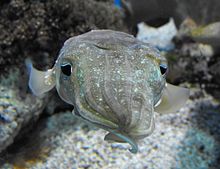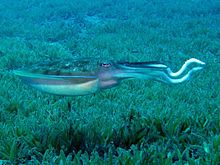- Pharaoh Cuttlefish
-
Pharaoh Cuttlefish 
Scientific classification Kingdom: Animalia Phylum: Mollusca Class: Cephalopoda Order: Sepiida Family: Sepiidae Genus: Sepia Subgenus: Sepia Species: S. pharaonis Binomial name Sepia pharaonis
Ehrenberg, 1831Synonyms - Sepia rouxi
Orbigny, 1841 - Sepia formosana
Berry, 1912 - Sepia formosana
Sasaki, 1929 - Sepia tigris
Sasaki, 1929 - Sepia torosa
Ortmann, 1888 - Crumenasepia hulliana
Iredale, 1926 - Crumenasepia ursulae
Cotton, 1929
The Pharaoh Cuttlefish (Sepia pharaonis) is a large cuttlefish species, growing to 42 cm in mantle length and 5 kg in weight.[1] When raised in the laboratory, the maximum recorded size for males is 16.2 cm, and for females 15.5 cm.[2]
Sepia pharaonis is likely a complex of at least three species, the distributions of which are not well understood.
The type specimen was collected in the Gulf of Suez and is deposited at the Zoologisches Museum in Berlin.[3]
Contents
Ecology
The Pharaoh Cuttlefish is native to at least the western Indian Ocean, including the Red Sea and Persian Gulf.[4] Of all the cuttlefish species in the Persian Gulf, it is the most commonly caught. Inhabiting the neritic zone, it is often found in depths up to 130 m.[2] When hunting at night, it swims up to shallower parts of the sea to feast on a variety of smaller fish, crabs, and occasionally other cuttlefish.[5]
Spawning times vary depending on its habitat. Near Hong Kong, it mates during Spring, from March to May. In the Red Sea area, it takes place from August to October.[5] After mating, the female deposits her eggs near the coast, between depths of 5 and 20 m.[2]
Human uses
It is a commonly fished species of cuttlefish in the Philippines, as well as the most economically important cuttlefish in the northern Indian Ocean. Off the coast of Australia, 90% of the cuttlefish caught are S. pharaonis.[2] It is often eaten by humans in these areas.
See also
References
- ^ Reid, A., P. Jereb, & C.F.E. Roper 2005. Family Sepiidae. In: P. Jereb & C.F.E. Roper, eds. Cephalopods of the world. An annotated and illustrated catalogue of species known to date. Volume 1. Chambered nautiluses and sepioids (Nautilidae, Sepiidae, Sepiolidae, Sepiadariidae, Idiosepiidae and Spirulidae). FAO Species Catalogue for Fishery Purposes. No. 4, Vol. 1. Rome, FAO. pp. 57–152.
- ^ a b c d Tehranifar, Akram (2011). General morphological characteristics of the Sepia Pharaonis (cephalopoda) from Persian gulf, Bushehr region. 11. IACSIT Press. http://www.ipcbee.com/vol11/24-T10009.pdf. Retrieved 4 October 2011.
- ^ Current Classification of Recent Cephalopoda.
- ^ Norman, M.D. 2000. Cephalopods: A World Guide. ConchBooks.
- ^ a b Nair (June 1993). "Stock assessment of the pharaoh cuttleflsh Sepia pharaonis". Indian Journal of Fisheries (Central Marine Fisheries Research Institute) 40: 85–94. http://eprints.cmfri.org.in/253/1/Article_09.pdf. Retrieved 9 October 2011.
External links

This Cuttlefish article is a stub. You can help Wikipedia by expanding it. - Sepia rouxi

